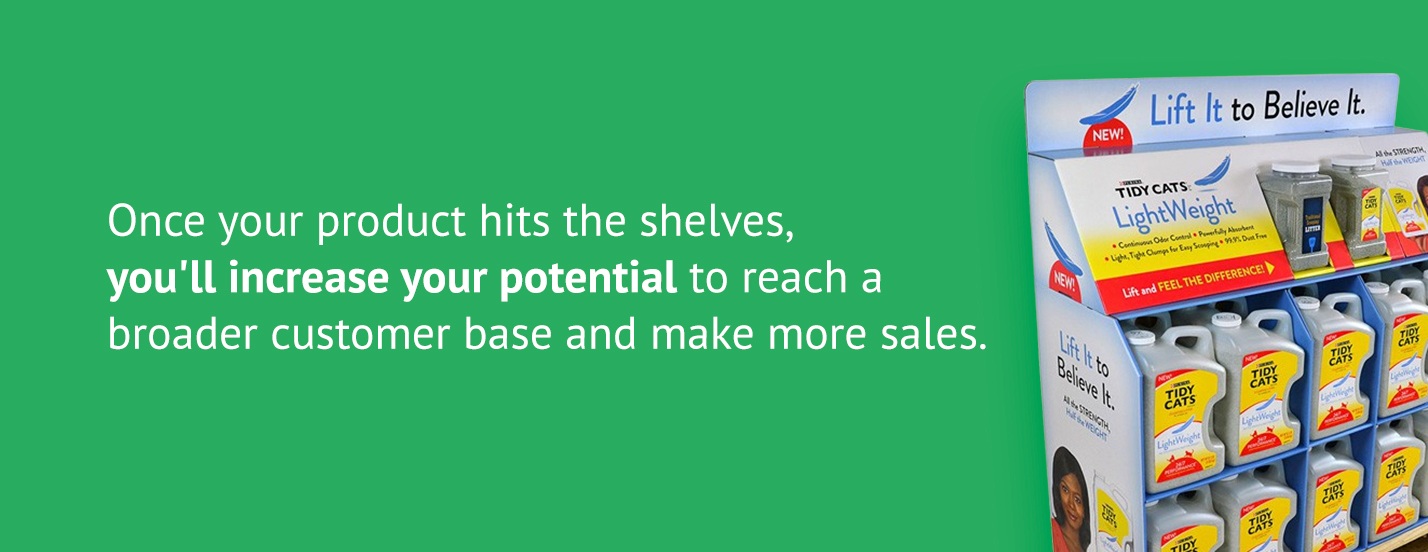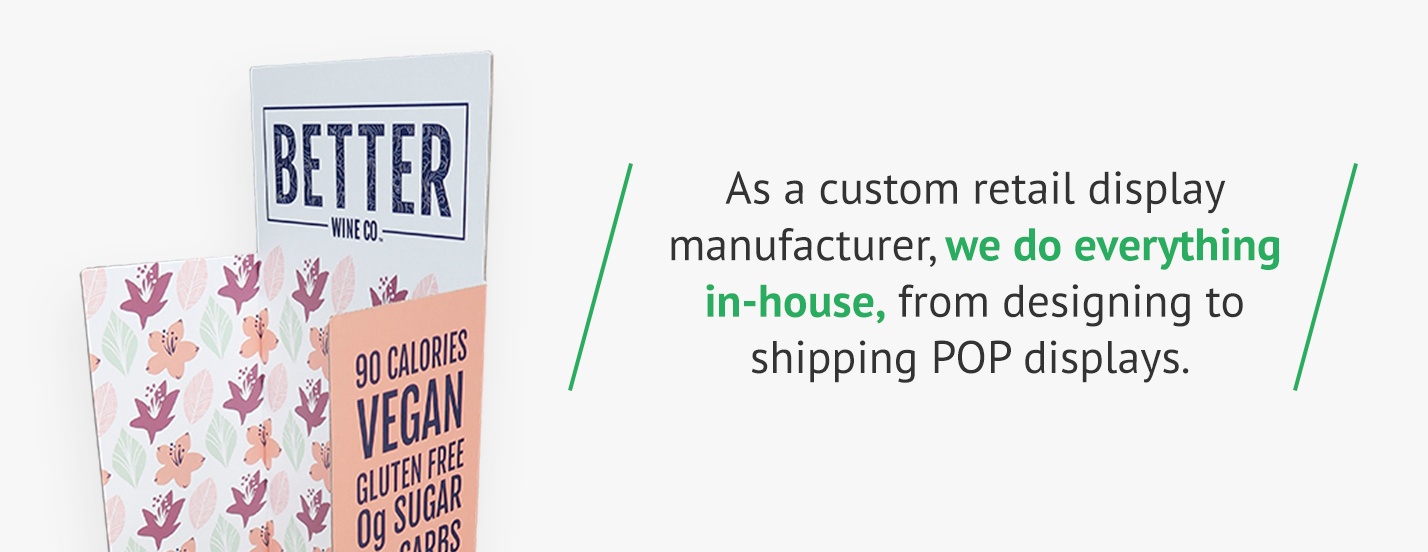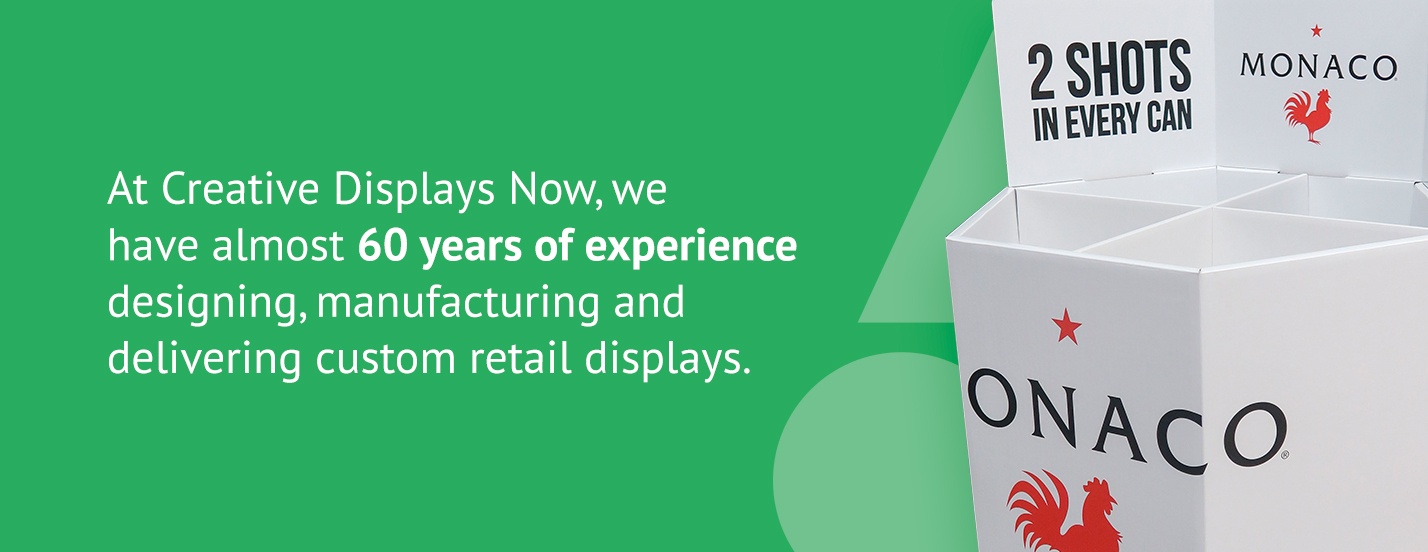Chapter 4: POP Display Design, Production and Shipping
Selling your product in a retail store is an exciting step. Once your product hits the shelves, you’ll increase your potential to reach a broader customer base and make more sales. First, you need a unique display that entices customers and gets your product out there. You may also need a fast turnaround time.
In this chapter, we’ll help you glide through the process, from design development to the shipping stage. If you’re ready to create your display and send it to retailers fast, we’re prepared to complete the entire process for you. Contact us today to get your estimate.
How Do You Design a Point-of-Purchase Display?
Some POP displays appear to be pretty straightforward. You might only see three different colors, for example, or nothing more than the brand’s logo and an image of the product.
However, no matter how simple or complex a POP display looks, its creation likely involved careful planning and plenty of research. When designing your custom display, it helps to consider the following factors:
Your Brand’s Logo
Before you choose a color palette for your display, look at your logo. Your brand’s logo should inspire your design choices, such as the colors and style to use.
For example, if your logo is sleek and modern, it probably doesn’t make sense to add a quirky cartoon character to your display. A display that complements your logo helps customers recognize and remember your brand.
Your Unique Strengths
What sets your company and products apart from your competitors? Is it the exciting ingredients list? Or is your brand playful while competitors are more serious?
Think about your company’s unique strengths and qualities, and consider how you might incorporate them in your display. You may only need to include a short, clear message on your display to highlight your product’s special benefits.
Your Product
The actual product should be the main feature of your POP display. Make sure your design complements your product’s packaging and doesn’t take attention away from your merchandise. In general, it’s best to design a display that’s simple and easy to understand and avoid visual clutter or confusing text.
The Retailer
Check your retailer’s specifications before designing your display because they’ll likely have size requirements you’ll need to follow. For example, according to Kroger’s display style guide, a full pallet display must not exceed 36 inches from top to bottom. Kroger also expects each display to maintain its structural integrity during the product’s promotion.
Retailers’ rules often change, so it’s important to stay up to date. If you have any questions about popular retailers’ latest specifications, feel free to ask us at Creative Displays Now.
Your Customers
Consider your customers and how you can trigger them to pick up your product. For instance, do you want to speak to busy moms who need convenient but healthy snacks for the kids? You might use a school-themed display. Or does your product appeal to young adults who consider themselves adrenaline junkies? Consider applying bold colors and high-energy graphics. Clearly define who your customers are, why they buy your product and what they expect of your brand. Use this information to guide your design.
Access
Make sure your display’s structure allows customers to grab items easily. As you design the display, imagine you’re a customer picking an item off the display’s shelf. Do the products fall over when one’s removed? Are they packed so tightly they’re hard to grip? The display should allow space between each item while keeping the products secure. A display manufacturer can help you design a unit that’ll make your products easy to grab and go.
Color
Colors are associated with different emotions and meanings. For example, yellow is often associated with joy, and red is connected to love. Although your logo and product’s packaging will be the primary factors guiding your color choices, it’s still worth considering other ways to use color. This doesn’t mean you need to go overboard with color, but you should choose your hues wisely to make the greatest impact. Colors catch customers’ eyes and make POP displays pop.
Your Competition
If you need some inspiration, it may help to check out what your competitors are doing. As you look at competitors’ displays, note what works and what you can do better. Also, pay attention to how your brand differs from competitors, and think of ways to highlight those differences.
Your Display Manufacturer
With everything to consider, designing an impressive POP display can seem like a challenge, especially on top of running a business. The good news is that you don’t have to face the challenge alone. Partner with an experienced display manufacturer who wants to help your project succeed from start to finish.
At Creative Displays Now, our design team will consider your brand, product, specifications and target audience to draw up an innovative design. We can also take your original idea and transform it into a stunning display. Once you’re satisfied with the design, we’ll create a prototype so you can provide feedback, and we can adjust the display accordingly. After you approve the prototype design, we’ll get to work printing your display.
How Are POP Displays Manufactured and Shipped?
Once you have a design ready to go, your display manufacturer can apply a printing method, such as digital printing, lithography or flexography, to bring your design to life. After your displays are manufactured, they’ll be shipped to their destinations.
As a custom retail display manufacturer, we do everything in-house, from designing to shipping POP displays. We’ll choose the highest quality printing method for your project size and design and ship your completed displays by truck or air to retail stores with detailed instructions for easy assembly. We can also assemble and pack products in the displays for you, making them ready for retailers.
Implementation Tips
You’ll probably feel relieved once you have a display ready to go. Still, you’ll need to keep an eye on your display even after it reaches customers. Keep these tips in mind:
- Make sure your display is organized and uncluttered.
- Keep your display clean and well-stocked.
- Consider including a brochure holder to educate customers about a new product.
- Arrange bulkier products on the bottom of the display to keep it balanced.
- Remember to evaluate your POP display’s performance.
Are Point-of-Purchase Displays Effective?
A catchy POP display is part of effective visual merchandising. With a clever display, you can draw customers to your product and persuade them to make a purchase. Even if customers know exactly what they want when they enter a store, an appealing POP display can cause them to pause and consider something new. POP displays enable you to reach your target audience at a critical moment — when they’re about to buy.
Overall, POP displays drive impulse buys and boost sales, and they don’t require a colossal budget. However, a POP display’s effectiveness largely depends on how well it’s designed. If you work with retail display experts, you can expect a high-quality, attention-grabbing display that will help you sell your products.
At Creative Displays Now, we have almost 60 years of experience designing, manufacturing and delivering custom retail displays. If you need an outstanding POP display for your product and a speedy turnaround time, we have the capabilities to make it happen. Reach out to us to learn more about our process or to start your project today.



